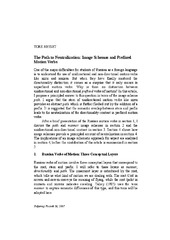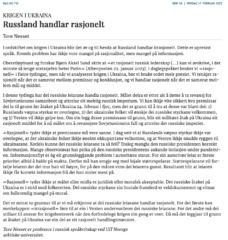Blar i forfatter Artikler, rapporter og annet (språk og kultur) "Nesset, Tore"
-
Norwegian agreement clashes on the football field
Nesset, Tore; Janda, Laura Alexis (Chapter; Bokkapittel, 2023)Kibrik 2019 argues that a cognition-to-form approach to agreement is superior to the traditional form-to-form approach that is fraught with problems. We concur that it makes more sense to examine agreement from the perspective of cognitive representation and present a small study of how the semantics of adjectives contributes to the use of singular vs. plural agreement with Norwegian collective nouns ... -
Norwegian Compounds and Corresponding Constructions in Russian: The Case of Nouns with Deverbal Heads
Nesset, Tore (Journal article; Tidsskriftartikkel; Peer reviewed, 2022-05-03)This article presents a corpus study of Norwegian compounds with deverbal heads (e.g., papirproduksjon ‘paper production’ from produsere ‘produce’) and corresponding constructions in Russian, such as the genitive (proizvodstvo bumagi ‘paper production’), the adjective (bumažnoe proizvodstvo ‘paper production’), the preposition (priglašenie na užin ‘dinner invitation’), and compound constructions ... -
‘Nu-drop’ in Russian verbs: a corpus-based investigation of morphological variation and change
Nesset, Tore; Makarova, Anastasia (Journal article; Tidsskriftartikkel; Peer reviewed, 2011)In the present article we are offering a corpus-based analysis of nu-drop in Russian verbs, the process whereby certain verbs with the suffix -nu- omit this morpheme in past tense forms. We will explore phonological, morphological and syntactic/semantic factors and show that inflectional and derivational morphology are the most important for nu-drop. Our study of the inflectional and derivational ... -
OLD CHURCH SLAVONIC BYTI PART ONE: GRAMMATICAL PROFILING ANALYSIS
Eckhoff, Hanne Martine; Janda, Laura Alexis; Nesset, Tore (Journal article; Tidsskriftartikkel; Peer reviewed, 2014) -
OLD CHURCH SLAVONIC BYTI PART TWO: CONSTRUCTIONAL PROFILING ANALYSIS
Eckhoff, Hanne Martine; Janda, Laura Alexis; Nesset, Tore (Journal article; Tidsskriftartikkel; Peer reviewed, 2014) -
Old Languages, New Ways?
Nesset, Tore (Chapter; Bokkapittel, 2015)Historical linguistics has always been a cornerstone in Russian studies, and most programs have traditionally included courses in Old Church Slavonic (OCS) and the history of Russian. But do such courses have a place in curricula of the future? In this article, I argue that historical linguistics is more relevant than ever, and I discuss seven pedagogical ... -
One or several categories? The Old Church Slavonic nǫ-verbs and linguistic profiling
Nesset, Tore (Journal article; Tidsskriftartikkel; Peer reviewed, 2012)In this article, I will investigate the Old Church Slavonic verbs with the -nǫ suffix, both the verbs that keep the nasal suffix throughout the paradigm (e.g. plinǫti ‘spit’) and the verbs that display -Ø in the past tense (e.g. pogybnǫti ‘perish’). Do these verbs constitute one or more linguistic categories? Having compiled a complete database of relevant verbs in Old Church Slavonic, I will argue ... -
Opaque softening. A usage-based approach.
Nesset, Tore (Journal article; Tidsskriftartikkel, 2005) -
The Path to Neutralization: Image Schemas and Prefixed Motion Verbs
Nesset, Tore (Journal article; Tidsskriftartikkel, 2007)One of the major difficulties for students of Russian as a foreign language is to understand the use of unidirectional and non-directional motion verbs like идти and ходить. But when they have finally mastered the directionality distinction it comes as a surprise that it only occurs in unprefixed motion verbs. Why is there no distinction between unidirectional and non-directional prefixed verbs ... -
Prezidentskie vybory vs. vybory prezidenta: how to choose?
Janda, Laura Alexis; Nesset, Tore; Say, Sergey (Journal article; Tidsskriftartikkel; Peer reviewed, 2019-10-24)We present three case studies of the distribution of adjective + head noun (‘adjective’) vs. head noun + noun-genitive (‘genitive’) constructions based on datasets extracted from the Russian National Corpus. Each case study focuses on a different set of non-head referents: case study 1 examines non-heads that are country names (like ‘Norway’ as in <i>norvežskij</i> N vs. N <i>Norvegii</i>), case ... -
Prostranstvo vo vremeni? Asimmetrija predloga v v prostranstvennyx i vremennyx konstrukcijax.
Nesset, Tore; Makarova, Anastasia (Chapter; Bokkapittel, 2015) -
Review of: M. Baerman (ed.). The Oxford handbook of inflection. Oxford: Oxford University Press, 2015. 688 p. ISBN: 978-0-19-959142-8.
Nesset, Tore (Journal article; Tidsskriftartikkel; Peer reviewed, 2018)Recent years have witnessed a steady stream of linguistics handbooks. The 688-page volume under review is part of a large series published by Oxford University Press involving handbooks on particular theories (e.g. Construction Grammar), subfields (e.g. sociolinguistics), and linguistic phenomena (e.g. compounding and derivational morphology). M. Baerman’s volume is a very valuable addition to the ... -
Russian feminitives: what can corpus data tell us?
Nesset, Tore; Piperski, Alexander; Sokolova, Svetlana (Journal article; Tidsskriftartikkel; Peer reviewed, 2022-07-22)Recent years have seen considerable debate concerning Russian feminitives, i.e. derived formations that designate female professionals, such as advokatka, advokatša, advokatessa, ženščina-advokat or advokat-ženščina that all refer to female lawyers. In this article, we investigate the use of feminitives based on data from the Araneum Russicum Maximum corpus and the Russian National Corpus. It is ... -
Russian ‘purely aspectual’ prefixes: Not so ‘empty’ after all?
Endresen, Anna; Janda, Laura Alexis; Kuznetsova, Julia; Lyashevskaya, Olga; Makarova, Anastasia; Nesset, Tore; Sokolova, Svetlana (Journal article; Tidsskriftartikkel; Peer reviewed, 2012)Nearly two thousand perfective verbs in Russian are formed via the addition of so-called “empty prefixes” (čistovidovye pristavki) to imperfective base verbs. The traditional assumption that prefixes are semantically “empty” when used to form aspectual pairs is problematic because the same prefixes are clearly “non-empty” when combined with other base verbs. Though some scholars have suspected that ... -
Russland handlar rasjonelt
Nesset, Tore (Chronicle; Kronikk, 2023-02-17)I ordskiftet om krigen i Ukraina blir det av og til hevda at Russland handlar irrasjonelt. Dette er upresist språk. Kremls problem har ikkje vore mangel på rasjonalitet, men mangel på informasjon. -
Second-Order Schemas and Active Subschemas : Vowel Reduction in Cognitive Grammar
Nesset, Tore (Journal article; Tidsskriftartikkel, 2006) -
Securing strategic input for L2 learners: Constructions with Russian motion verbs
Nesset, Tore; Janda, Laura Alexis (Chapter; Bokkapittel, 2022-02-21)This article shows how constructional and usage-based approaches to linguistics can be used to identify strategic input for L2 learners, i.e. input that reflects high frequency patterns in the target language. We suggest a methodology combining constructional and grammatical profiles, and argue that this methodology enables us to identify the most relevant morphological and syntactic constructions, ... -
Skriv mer om klassisk musikk!
Nesset, Tore (Chronicle; Kronikk, 2022)I et tankevekkende intervju i Adresseavisen på lørdag tar dirigenten og bratsjisten Torodd Wigum til orde for bedre mediedekning av klassisk musikk. Det er gode grunner til å støtte Wigums initiativ. Men Wigum sier ikke mye om hva slags musikkjournalistikk han vil ha. La oss ta debatten! -
Some notes on temporal adverbials in Old Russian: the case of <i>lěto</i> ‘year’ in Suzdal’skaja letopis’
Nesset, Tore (Journal article; Tidsskriftartikkel, 2012)This article offers a small analysis of temporal adverbials with ‘year' in Suzdal'skaja letopis'. These data in comparison with data from Ipat'evskaja letopis' indicate that въ + locative (the construction that prevails with ‘year' in Contemporary Standard Russian) was marginal in Old Russian, whereas three other constructions (въ + accusative, bare genitive and bare locative) competed for dominance. -
Space-time asymmetries: Russian v ‘in(to)’ and the North Slavic Temporal Adverbial Continuum
Nesset, Tore; Makarova, Anastasia (Journal article; Tidsskriftartikkel; Peer reviewed, 2013)This article presents a corpus-based investigation of temporal adverbials with special focus on Russian в ‘in(to)’ and its cognates in North Slavic (Belarusian, Ukrainian, Polish and Czech). We advance the Constraint Hypothesis, according to which case government is more restricted in the domain of time than in the domain of space. This hypothesis receives support from the five languages under ...


 English
English norsk
norsk


















